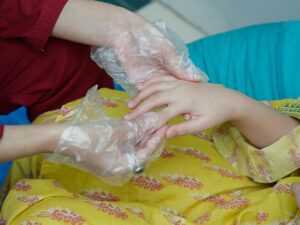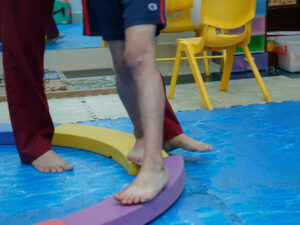When should we go for Occupational / sensory integration therapy
Occupational therapy is a healthcare profession that aims to help a person achieve success in those tasks that occupy their time. This typically means playing and learning as well as eating, getting dressed, grooming and so on for children. An OT provides carefully designed challenges (therapeutic or purposeful activities) and assistive technology to build and assist developmental skills such as
- Sensory processing (taste, smell, hearing, touch, vision, movement, internal body awareness, attention span, and arousal level)
- Fine and gross motor skills(including all physical milestones to individual skills)
- Activity of daily living skills (ADLs)
- Handwriting
- Visual perception
Therapeutic Activities
Therapeutic Activities are tasks that are functionally designed from daily activities and used as a treatment to improve strength and range of motion. These are functional and simple tasks that directly imitate real-life activity. Examples include lifting a weighted object and placing it on the top shelf, which is mainly to strengthen overhead shoulder movement.
Sensory Processing
Sensory processing is the meaningful reception, registration and interpretation process of sensory input from the different body senses and the environment. It is the process in which brain receives input from all possible resources including internal and external stimuli, organizes and responds to react in a control and constant manner.
Sensory processing receives background information from internal and external (environment) resources. The internal stimuli received from within the body through different senses, basic and most important are the following;
Visual Sense: Visual sense is responsible for seeing. The visual system uses the eyes to receive information, color, and movement.
Auditory Sense: Auditory sense is responsible for hearing. The auditory system uses the outer and middle ear to receive sound information. They receive information about volume, pitch and rhythm.
Olfactory Sense: Olfactory sense is the ability to interpret smells. It uses the nose to receive information about the chemical makeup of particles in the air to determine if the smell is safe or harmful.
Tactile sense: Tactile processing is responsible for touch perception. Its receptors are situated in the skin to receive touch sensations like pressure, vibration, movement, temperature, and pain. It is very important for the overall neural organization.
Proprioceptive Sense: Proprioceptive sense is the ability to interpret where your body parts are in relation to each other. It uses information from nerves and sheaths on the muscles and bones to inform about the position and movement of body through muscles contracting, stretching, bending, straightening, pulling, and compressing.
Vestibular sense: Vestibular sense is the ability to interpret information relating to movement and balance. The vestibular system uses the semi-circular canals in the inner ear to receive information about movement, change of direction, change of head position, and gravitational pull. It receives information about how fast or slow we are moving, balance, movement from the neck, eyes, and body, body position, and orientation in space.
Fine and Gross Motor Skills
Fine and Gross Motor Skills: Skills involving movement of large muscles, such as independent sitting, crawling, walking and running.
Fine Motor Skills: Skills involve use of smaller muscle movement, such as grasping, object manipulation, and pencil holding.
ADLs (Activities of Daily living skills)
Activity of daily living skills are basic self-care tasks that we learn in daily life, walking, feeding, dressing and grooming, toileting, bathing and transferring.
IADLs (Instrumental Activities of Daily living skills)
IADLs are not necessary for fundamental functioning but are related to independent living in a community such as cleaning and maintaining the house, managing money, moving within the community, preparing meals, shopping for groceries and necessities, taking prescribed medications, Using the telephone or other form of communication.
Handwriting skill: writing is a complex fine motor task for using language by pencil grip, letter formation, and body posture.
Visual Perception: Visual perception is the ability to see, organize and perceive our surroundings. The visual perception of colors, patterns, and structures are basic to respond appropriately, without visual perception, you would not be able to recognize common objects and have the eye-hand coordination required for many daily tasks.
Conditions Treated
Occupational therapy (OT) focuses on the treatment of physical, sensory, or cognitive disabilities including
- Autism spectrum disorder(ASD)
- Sensory processing difficulties: Sensory processing difficulties are related to problems in receiving, organizing and responding to information gathered through all the internal and external sources of input.
- Cerebral Palsy (CP) is defined as a persistent but unchangeable disorder of movement.
- Children with genetic conditions/syndromes
- Developmental Delay / Learning Difficulties
- Developmental Co-ordination Disorder / Dyspraxia
- Visual Perceptual Difficulties
- Poor Social Skills
The basic Occupational therapy areas of assessment are the following
- Physical/Development evaluation
- Sensory processing
- Balance, coordination and visual perception skills
- Fine motor and gross motor evaluation
- Hand Dexterity/handwriting skills
- Self-care skills
- Social and play skills
“Occupational Therapists work with people of all ages, helping them to carry out the activities that they need or want to do in order to lead healthy and fulfilling lives.”
(British Association of Occupational Therapists)



